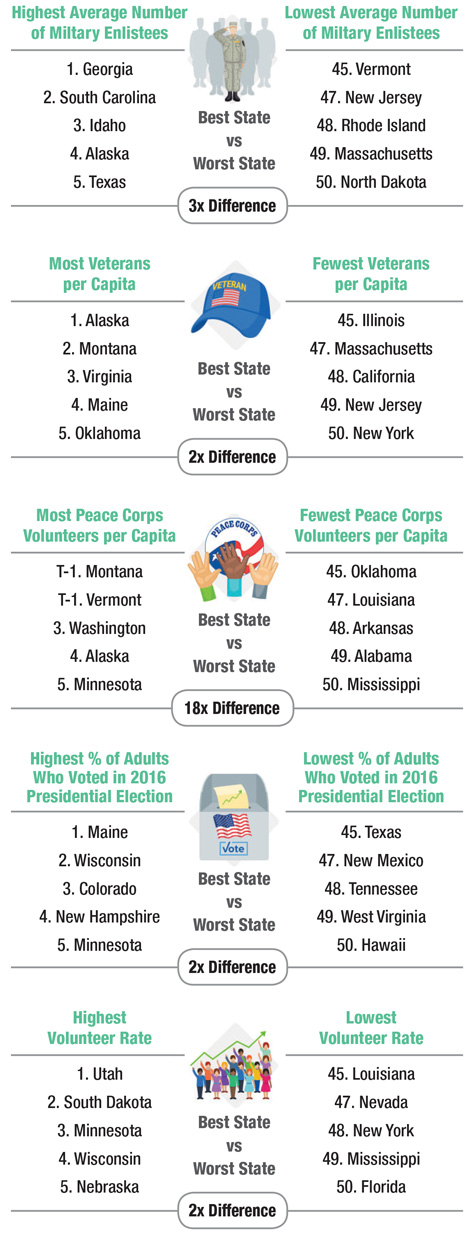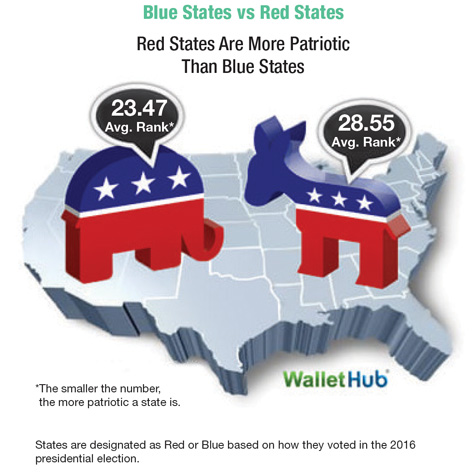Expressions of American patriotism come in many forms — from setting off fireworks during Fourth of July and buying American made goods to paying taxes and serving in the armed forces. But some states are better than others at showing their national pride.
In order to determine where Americans bleed the most red, white and blue, WalletHub’s data team compared the states across 13 key indicators of patriotism. Our data set ranges from share of enlisted military population to share of adults who voted in the 2016 presidential election to AmeriCorps volunteers per capita.

| Overall Rank |
State |
Total Score |
‘Military Engagement’ Rank |
‘Civic Engagement’ |
1 |
Virginia |
70.55 |
5 |
10 |
2 |
Alaska |
70.40 |
1 |
36 |
3 |
Wyoming |
67.54 |
7 |
7 |
4 |
South Carolina |
65.03 |
3 |
25 |
5 |
Colorado |
63.59 |
12 |
9 |
6 |
Washington |
62.48 |
11 |
11 |
7 |
Hawaii |
62.30 |
2 |
39 |
8 |
Idaho |
61.97 |
9 |
16 |
9 |
Georgia |
60.39 |
4 |
40 |
10 |
North Carolina |
59.34 |
6 |
20 |
11 |
Maine |
58.82 |
29 |
3 |
12 |
South Dakota |
56.81 |
20 |
15 |
13 |
New Hampshire |
56.63 |
33 |
4 |
14 |
Oklahoma |
56.25 |
8 |
31 |
15 |
Kansas |
55.04 |
14 |
22 |
16 |
Nebraska |
54.49 |
24 |
13 |
17 |
Maryland |
54.40 |
28 |
12 |
18 |
Utah |
53.70 |
37 |
2 |
19 |
Arizona |
53.41 |
17 |
27 |
20 |
Mississippi |
53.20 |
16 |
29 |
21 |
Vermont |
52.89 |
39 |
1 |
22 |
Montana |
51.98 |
15 |
35 |
23 |
Nevada |
51.43 |
18 |
28 |
24 |
Missouri |
50.91 |
22 |
24 |
25 |
North Dakota |
50.56 |
31 |
14 |
26 |
New Mexico |
50.45 |
21 |
30 |
27 |
Alabama |
50.07 |
10 |
46 |
28 |
Wisconsin |
49.42 |
41 |
6 |
29 |
Iowa |
48.49 |
40 |
8 |
30 |
Texas |
48.25 |
13 |
47 |
31 |
Florida |
48.01 |
19 |
43 |
32 |
Minnesota |
44.85 |
46 |
5 |
33 |
Louisiana |
44.46 |
30 |
33 |
34 |
Arkansas |
44.23 |
23 |
45 |
35 |
Ohio |
44.17 |
34 |
26 |
36 |
Kentucky |
44.10 |
27 |
38 |
37 |
West Virginia |
43.60 |
36 |
21 |
38 |
Tennessee |
42.40 |
26 |
44 |
39 |
Oregon |
42.13 |
32 |
41 |
40 |
Indiana |
42.02 |
35 |
34 |
41 |
Delaware |
40.40 |
25 |
49 |
42 |
Pennsylvania |
39.98 |
45 |
17 |
43 |
Michigan |
38.96 |
42 |
19 |
44 |
California |
37.70 |
38 |
42 |
45 |
Connecticut |
36.25 |
47 |
18 |
46 |
New York |
30.59 |
50 |
23 |
47 |
Rhode Island |
29.90 |
44 |
48 |
48 |
Massachusetts |
28.88 |
48 |
32 |
49 |
Illinois |
28.41 |
43 |
50 |
50 |
New Jersey |
27.46 |
49 |
37 |


Patriotism can be a complex subject, depending on who’s involved in the discussion. For insight, we asked a panel of experts to share their thoughts on the following key questions:
 |
G. Terry Madonna
|
What are the characteristics of a good patriot?
The first characteristic is a deeply held loyalty to the country, sometimes interpreted as nationalism, and a fierce pride in being American. That certainly does not mean a loyalty to any particular party or candidate. For some, that gets translated into various forms of civic engagement, such as voting, running for office, active involvement in civic organizations, and service in the military are among the most prominent factors.
Another factor involves referencing the “creed,” the founding documents, usually the principles enunciated in the U.S. constitution and a reliance on our country’s history.
What is the relative influence of economic incentives versus patriotic intentions when deciding whether or not to join the military? Has this changed over time?
The decision to join the military is more complex than just a matter of economics. Yes, the economic situation does play a role for some, but research has shown that a variety of circumstances and factors affect one’s decision to join the military.
For example, as a 2011 Pew survey of veterans pointed out, serving the country motivated those who wanted to join the military, and that certainly represents a form of patriotism. The second reason given was the ability to access the accompanying educational benefits provided by the military.
Now, this consideration has some economic aspects to it, as slightly more than one-in-four interviewees cited a tough time finding civilian employment as reason to enlist.
And so, the economic argument and prospects for civilian employment can’t be dismissed. There is another factor relating to population density. States with less population density tend to produce the highest level of recruits, perhaps, because of fewer economic opportunities in those states, and the fact that many recruiting stations are located in those areas.
Is there a link between socioeconomic class and level of patriotism?
As previously mentioned, serving in the military is one form of patriotism. A study done by the National Priorities Project concluded that lower income and higher income folks had the lowest enlistment rates, and the middle class had the highest. That could qualify the latter group as the most patriotic. But if one looks at voting as a key factor in patriotism, then folks with higher education levels and higher incomes would qualify.
Conclusion: It’s not easy to definitively point to a single factor or link.
Has there been a shift in the way younger generations perceive and express their patriotism?
It seems that millennials have found different ways to show what might be called patriotism. They are much less likely to join a political party, and they are more skeptical of big institutions than other age cohorts. It looks like their patriotism is expressed by engaging in a variety of community activities, such as volunteering in organizations that promote social causes, joining groups that provide service to needy groups, as well as single issue groups that support a variety of cultural issues and other forms of protest activities. They don’t seem to connect service in the military as a form of patriotism.
Should we be raising our children as global citizens first or as Americans first?
Personally, I don’t think the answer lies in selecting one or the other. There is certainly a set of interests involving our national and economic security that require we be careful to protect our citizenry. Still, we are also members of the global community.
More than that, after World War I, we moved away from the isolationist tendencies that have been prevalent in American history. We became the dominant economy, the protector of the free world and the defender of democracy.
There is much that we have done and can continue to do to assist struggling nations without damaging our own interests, and continue to defend the free world against tyranny.
That means we have to provide a balance in how we conduct our national policies.
What measures should schools and local authorities undertake in order to promote patriotism among citizens?
As someone who taught American history and government for many years, one aspect of the answer lies in what we do in our schools. We need to teach the history of our country noting the struggles that have taken place to move our nation forward. That would importantly include the principles of our founding and the evolution of democracy. That does not mean we should give short shrift to our nation’s shortcomings, such as slavery and racism, and many other elements of our history.
It is also important for the schools and other institutions to promote civic engagement and a commitment to service. That translates into voting, even seeking public office. These conversations need to include the values of diversity and tolerance, as well as an enriched sense of American history and culture.
When evaluating the most patriotic states in America, what are the top five indicators?
There is no way to know for sure the top indicators. That relies on some consensus of how one defines patriotism. It could relate to voting, to service to the larger community, to service in the military, and other factors. A previous study conducted by WalletHub included a model to quantify a state’s degree of patriotism, using military service and civic engagement.
The conclusion the study found was that the ten most patriotic states were Maine, Wyoming and Arizona, with the remaining ones hailing from the southeastern part of the country.
Dr. Madonna’s responses were based on his own knowledge on patriotism and national identity, as well as on James Connolly’s primary research on the topic. James is a student intern at Franklin & Marshall College.
 |
Francesco Duina
|
What is the relative influence of economic incentives versus patriotic intentions when deciding whether or not to join the military? Has this changed over time?
This is a tough question to answer. We know that young men and women from less privileged backgrounds tend to join the military more (in per capita terms) than people from other social extractions. But the differences in numbers may not be as big as one might expect. And, among the very least well-off, the numbers are not necessarily very high.
The lower middle class appears to be perhaps the biggest contributor. This suggests that economic incentives matter. At the same time, we know that patriotism is very high in all classes, and especially those with fewer economic means. So, perhaps it is a combination of economic need and love of country.
To this we must add another important driver: a history of service in the family. This, again, tends to be quite common in the middle and lower middle classes. So, several different factors seem to be at work together. Teasing them out is not easy.
Is there a link between socioeconomic class and level of patriotism?
If you look at data from the General Social Survey or the World Values Survey you see a couple of interesting things. First, in the United States, patriotism is very high across all socioeconomic classes and higher than that found in many other advanced countries in the world.
On average, depending on how you measure it, close to 90% of respondents in any socioeconomic class will tell you that they love the United States, that they think it is one of the best countries on Earth, that they rather be citizens of the United States than of any other country, that it is God’s country, and so on.
Secondly, Americans coming from the lowest socioeconomic classes appear to be the most patriotic, along, in some cases, with the richest Americans. Interestingly, the patriotism of America’s poor appears also to be quite resilient.
While the patriotism of wealthier Americans showed some negative trends following the 2008-2009 financial crisis, that of poorer Americans seems to have held steady. On the whole, then, Americans with limited socioeconomic means appear to be exceptionally patriotic.
Has there been a shift in the way younger generations perceive and express their patriotism?
Recent surveys by organizations like the Pew Research Center suggest that younger Americans are less patriotic than older ones. To be sure, they are still on the whole quite patriotic. But there is definitely a gap. In the 2013 Pew Research survey, 70% of Millennials agreed with the statement “I am very patriotic.” But Gen Xers came in at 86%, Boomers at 91%, and Silents at 90%.
A gap is also observable among poorer Americans, who are, as I noted already, a particularly patriotic group: poor young Americans are less patriotic than poor older ones. The gap varies depending on the metrics one uses to measure patriotism. It is usually around 10-20%. All this suggests a difference between generations in the nature of their patriotism. Yet, they also seem to share much in common. All generations, for instance, appear to ground their patriotism in the freedom they think America stands for.
Should we be raising our children as global citizens first or as Americans first?
This is of course a personal perspective. In my view, national identity can provide people with a much needed sense of dignity. It can also encourage participation in civic life, from voting to taking care of public spaces. At the same time, it can breed a sense of superiority, aggressive behaviors toward others, and various kinds of provincialism.
We certainly continue to live in a world of nations more so than a globalized world. My view, overall, is that patriotic narratives should be toned down in favor of a more global sense of citizenship. Many of the problems we face today are global or regional, for instance, Europe or the Middle East rather than national. The solutions will come from regionally, and globally, minded people.
When evaluating the most patriotic states in America, what are the top five indicators?
Much can be gained by looking at social scientific survey data. We have a considerable amount of information on how people in different states feel toward the greatness of the United States, their love of it, their commitment and readiness to serve, etc. Yet, there are alternative indicators too, even if these may not be readily available and would require some original data collection.
For instance, how many homes display American flags in their front yards? Is the Pledge of Allegiance still recited in the public school system? How well attended are public events such as 4th of July paraded or Memorial Day remembrances? I would think these would be great indicators to use.